Automating Data Extraction from Bank Statements Using a Custom Trained AI Model
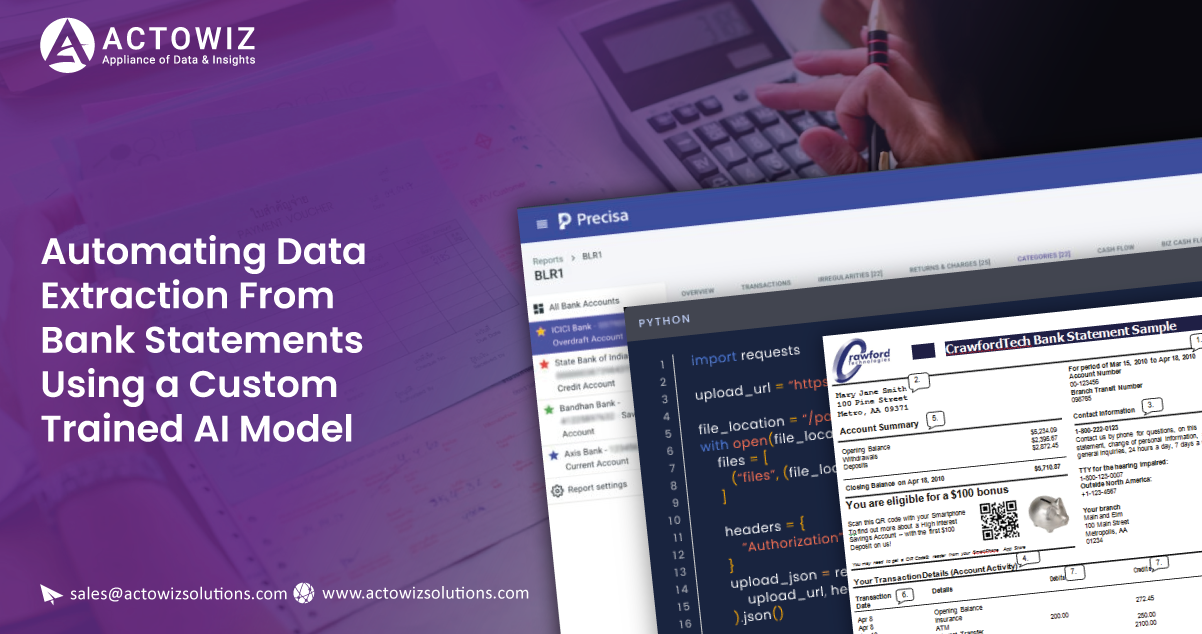
In accounting, automating data extraction from bank statements is crucial in enhancing efficiency and accuracy in financial transactions. With the exponential growth of data and the limitations of manual data entry, it has become imperative to leverage custom-trained AI models and automated table extraction techniques to streamline the process.
This tutorial blog will explore how to program data scraping from bank statements with today’s advanced technologies.
Table Extraction
Bank statements typically follow a tabular format with important financial transaction details organized in a table. Alongside the structured table are sections of unstructured text found at the beginning of the statement, which often contains information like the address, bank name, and statement period.
To automate web extraction from different bank statements, it is important to use techniques for precisely scraping information from both the structured table and the unstructured text sections. This can be achieved through custom-trained AI models and automated table extraction methods, which enable efficient and accurate data retrieval from the various components of the bank statement.
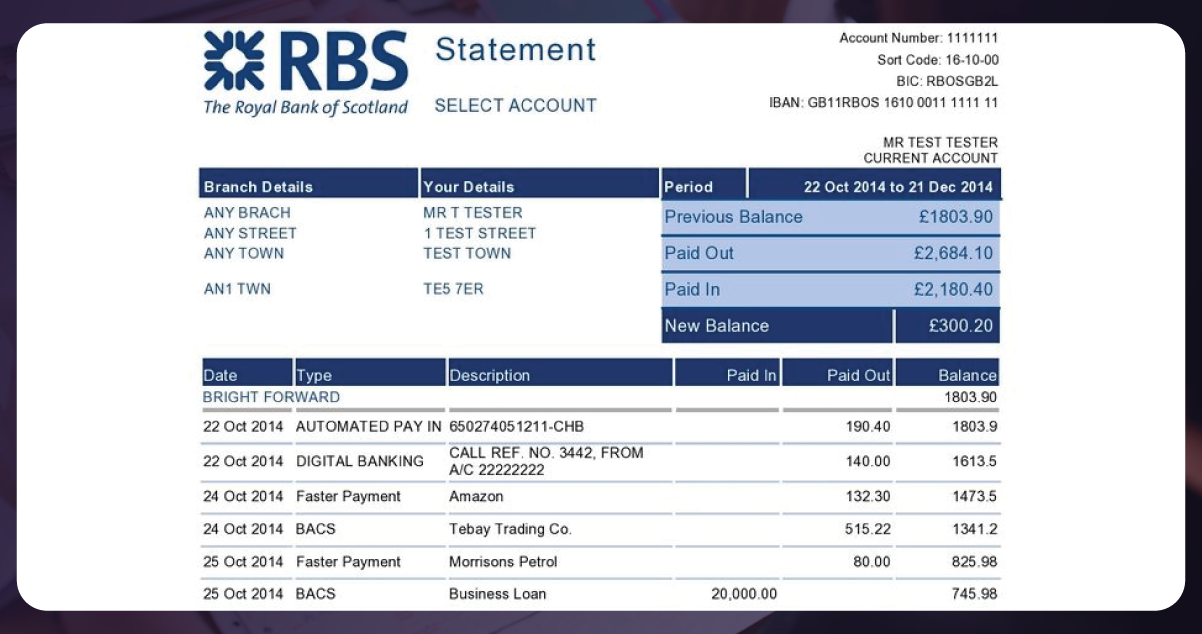
It is often more efficient to utilize pre-trained tabular extraction APIs such as those provided by Microsoft Azure or AWS to streamline the process of extracting structured data from bank statements. These APIs have been trained on vast amounts of data and can accurately extract information from organized tables.
One example of automated table extraction is using UBIAI (Universal Bank Information AI), which leverages Microsoft Azure API for this task. UBIAI can automatically recognize and extract specific types of information, such as amounts, dates, and statement periods, from unstructured bank statements.
By integrating UBIAI with the Microsoft Azure API, you can benefit from the advanced capabilities of the pre-trained model to efficiently extract structured data from bank statements. This approach saves time and effort compared to training a custom NLP model specifically for tabular data extraction, as the pre-trained APIs have already been trained on millions of examples and are designed to handle this task effectively.
AI Model Training
Once the tables have been reliably extracted from the bank statements, the next step is to train an AI model to extract the relevant information at the top. The UBIAI Annotation Tool can be utilized to streamline this process, requiring only the labeling of a small subset of documents to train the AI model effectively.
Using the UBIAI Annotation Tool, you can quickly annotate and label the necessary information within five bank statement documents. This annotated data will serve as the training set for the AI model, enabling it to learn and accurately extract relevant information from similar documents.
The simplicity and efficiency of the annotation process provided by the UBIAI Annotation Tool allow you to quickly train a custom AI model without requiring extensive manual labeling. This approach ensures that the model is explicitly trained for extracting relevant information, optimizing its performance, and enhancing the automation of data extraction from bank statements.
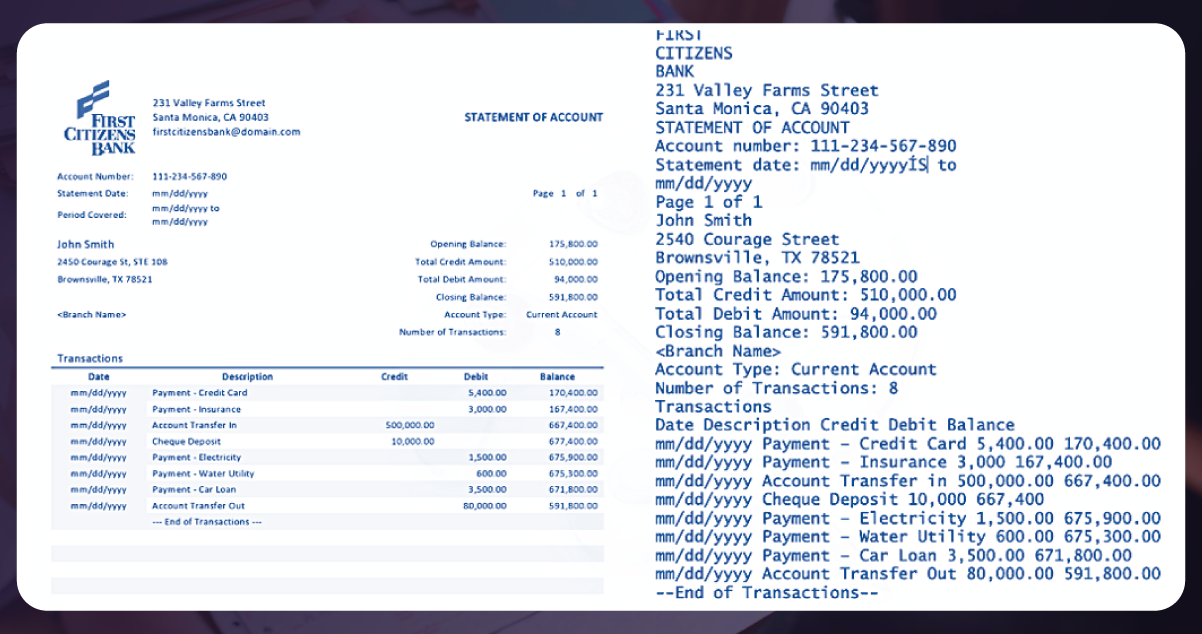
Training the model is a straightforward process in UBIAI. Just navigate to the Models menu, select the project containing the labeled data, and click the “Train” button. The platform handles the training process for you, eliminating the need for coding or complex technical steps.
By following these simple instructions, UBIAI will initiate the model’s training using the labeled data from the project. This seamless approach allows you to focus on the data extraction task without the added complexity of manual coding, making the training process accessible and efficient for users of any technical background.
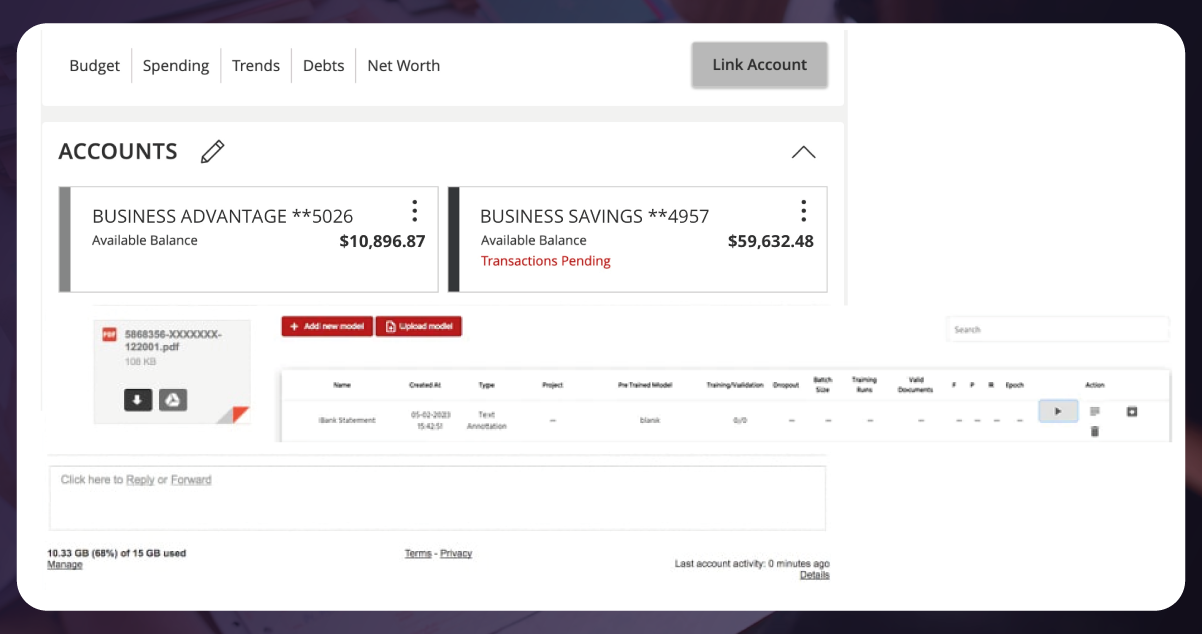
Creating a Custom Workflow for Bank Statement Information Extraction
Once the model is trained, it’s time to integrate the table extraction and custom-trained model into a seamless workflow that automatically extracts the relevant information from bank statements. To achieve this, we can leverage AI Builder’s capabilities, allowing users to deploy their models and create custom workflows with just a few clicks.
With AI Builder, users can combine modules such as image processing, OCR (Optical Character Recognition), custom NLP models, table extraction, and LLMs (Language Models) to create a tailored solution that addresses their specific use case. This flexibility enables the creation of powerful workflows that automate the extraction of information from bank statements.
For this tutorial, we will utilize the following workflow to accomplish our goal:
Image Processing: Preprocess the bank statement images to enhance clarity and optimize them for extraction.
Table Extraction: Employ pre-trained table extraction APIs to accurately extract structured data from the bank statement tables.
Custom-Trained Model: Utilize the custom-trained model to extract the relevant information at the top of the statement, such as addresses, bank names, and statement periods.
By combining these modules within the workflow, users can create a comprehensive solution that seamlessly extracts structured and unstructured data from bank statements. Please refer to the introductory article provided for more detailed information and guidance.
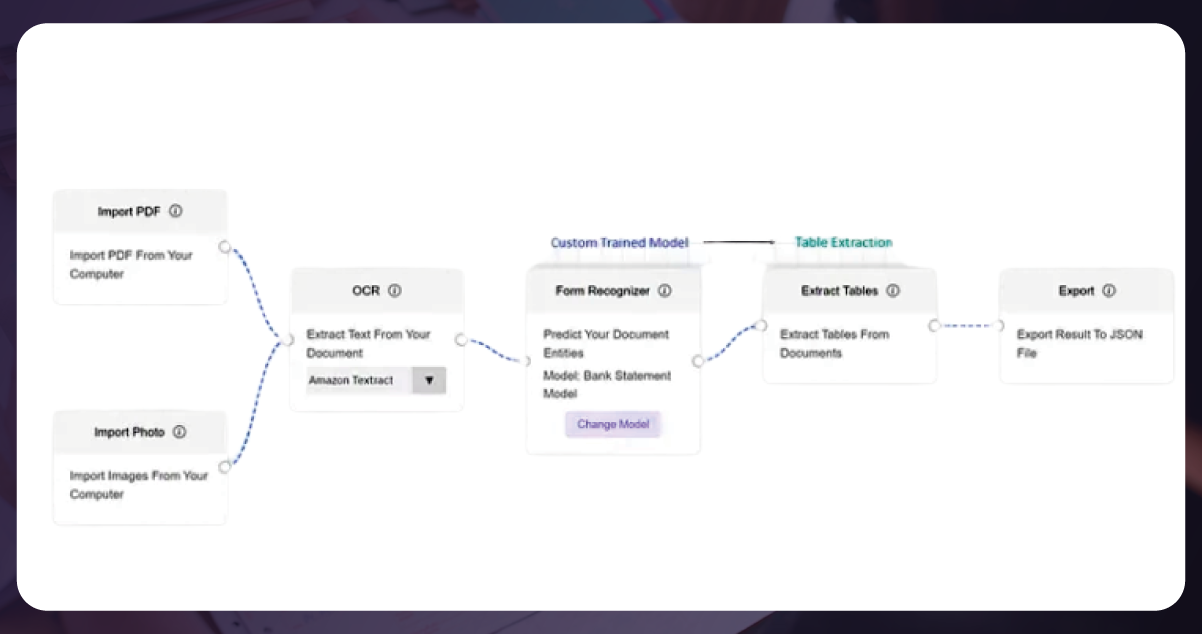
Running the Custom Workflow for Bank Statement Information Extraction
Once the workflow has been created in AI Builder, we can run it on new bank statements to extract the relevant information. Let’s follow the steps below:
Document Import: Drag & drop Photo and PDF modules into the AI Builder canvas to import the bank statement documents. Connect the results of data importers to input of an OCR module, which will parse data from image and PDF files.
OCR Module: Add the OCR module to extract text from the imported bank statements. Connect the output of the OCR module to further processing steps.
Form Recognizer: Include the Form Recognizer module to import your custom-trained AI model. This model is specifically trained to extract the desired information from the bank statements. Connect the output of the OCR module to the input of the Form Recognizer module.
Extract Tables: Add the Extract Tables module to read the structured tables from the bank statements. Connect the output of the Form Recognizer module to the input of the Extract Tables module.
Export Module: Finally, connect the output of the Extract Tables module to the export module. This will allow you to export the extracted data in the desired format, such as a spreadsheet or database.
By combining the custom-trained AI model with other data processing modules in AI Builder’s modular custom workflow, you can easily automate the extraction of relevant information from bank statements. Simply run the workflow on new bank statements, and the system will process the documents, extract the necessary data, and provide the output according to your desired configuration.
With minimal effort, you can use AI Builder’s intuitive interface and pre-built modules to streamline the entire process and achieve efficient and accurate data extraction from bank statements.
Bank Statement Processing: Reviewing and Correcting Output
Once the bank statements have been processed using the custom workflow in AI Builder, it’s essential to review and correct the output before exporting the extracted data. AI Builder provides a user-friendly review dashboard that allows you to visualize and review the output of each module in the workflow.
The review dashboard enables you to examine the results of the data importers, OCR module, Form Recognizer, Extract Tables module, and any other modules used in the workflow. You can inspect the extracted data, compare it with the original bank statements, and make necessary corrections or adjustments.
This review process is crucial to ensure the accuracy and quality of the extracted information. It allows you to catch any potential errors or discrepancies and rectify them before exporting the final data.
AI Builder’s review dashboard provides an intuitive interface that facilitates the review and correction process. You can easily navigate the module outputs, view the extracted data, and validate its correctness. Once satisfied with the reviewed output, you can export the data in your desired format for further analysis or integration into other systems.
By leveraging AI Builder’s review dashboard, you can ensure the accuracy and reliability of the extracted data, contributing to more efficient and reliable bank statement processing.
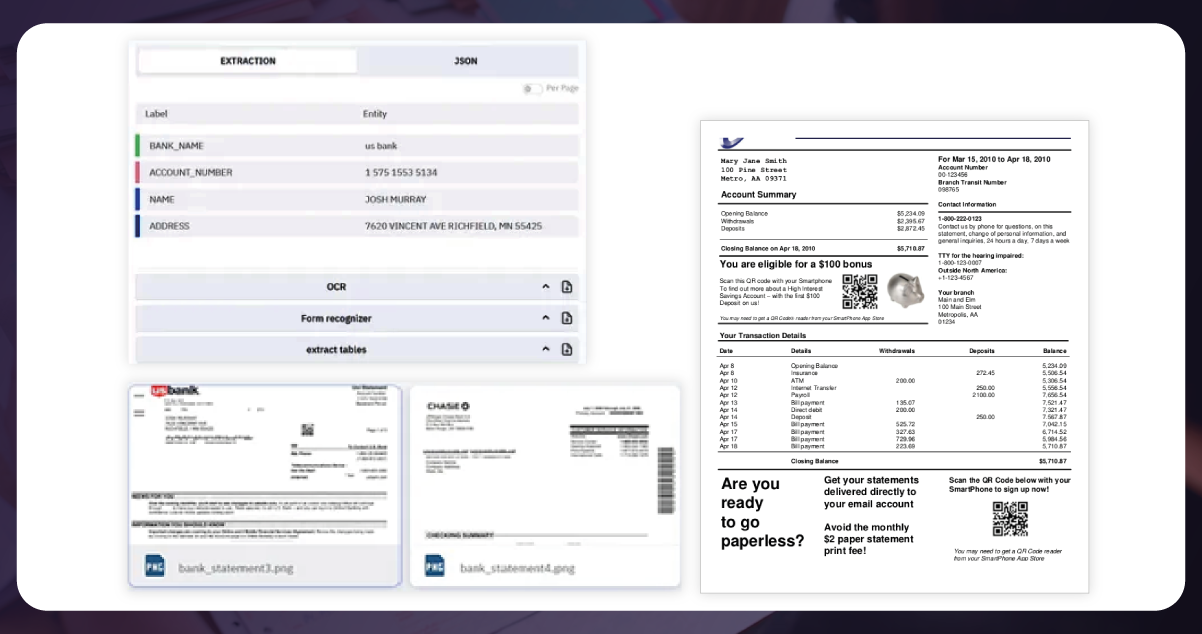
The AI extraction is shown on the right panel containing the entities Bank Name, Account Number, Name and Address which have been extracted correctly using our custom AI model.
We can also see the extracted tables:
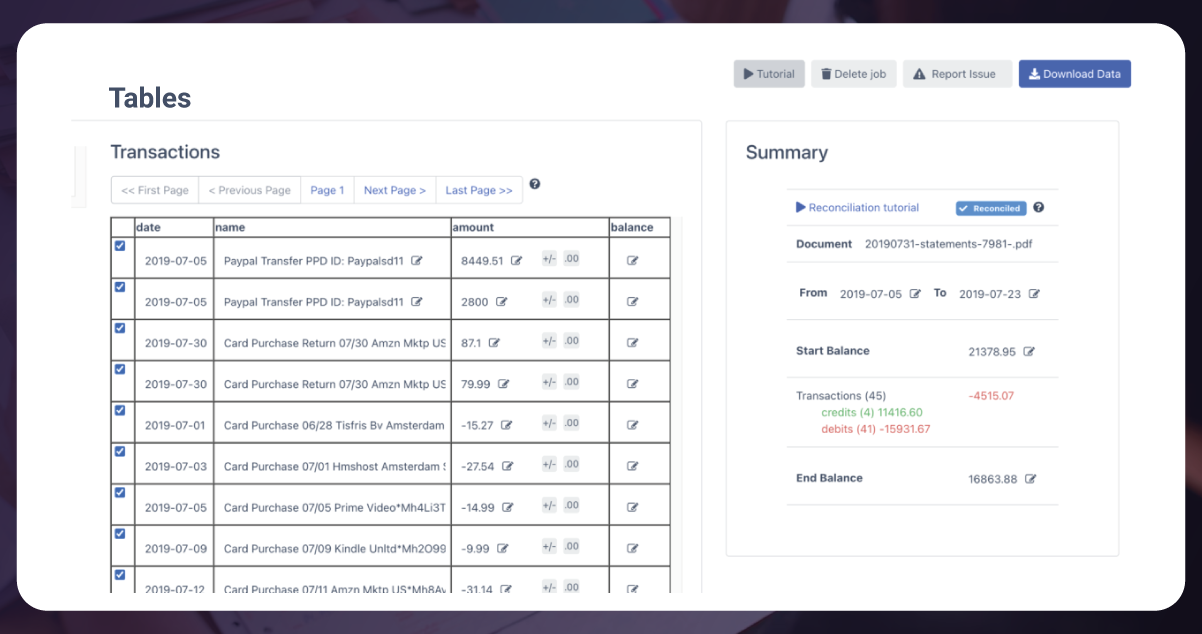
Once the data has been reviewed and corrected, export it in a CSV (Comma-Separated Values) file format. The CSV format is commonly used for storing tabular data and can be easily opened and manipulated in spreadsheet software or imported into databases.
Conclusion
The AI Builder’s capability to create custom workflows provides a significant advantage, enabling easy adaptation to different types of bank statements and other financial documents. This flexibility makes the solution highly valuable for financial institutions that regularly deal with a diverse range of financial documents.
We highly recommend scheduling a demo if you want to automate data extraction from bank statements and experience the benefits firsthand. Our team will be delighted to showcase the solution’s capabilities and guide you through the process. Don’t miss the opportunity to streamline your financial document processing and enhance operational efficiency. Schedule a demo today! You can also contact us for all your mobile app scraping, instant data scraper, web scraping service requirements.
sources >> https://www.actowizsolutions.com/automating-data-extraction-bank-statements-using-ai-model.php
tag : #AutomatingDataExtractionBankStatements
#scrapecustomtrainedAImodels
#Automatedbankdataextraction
#Automatedataextraction

